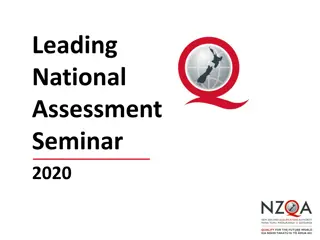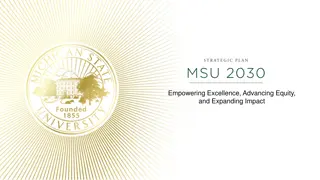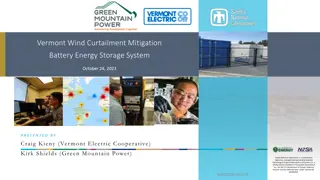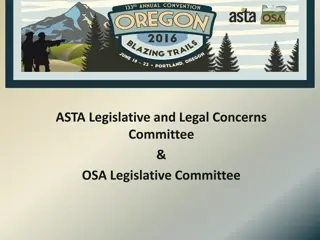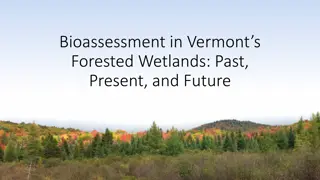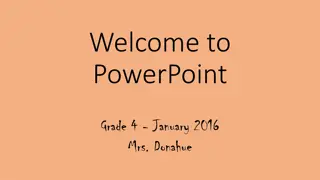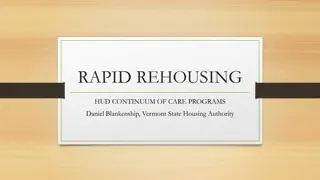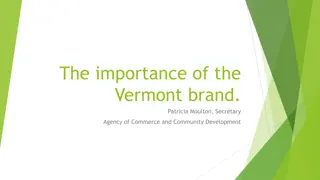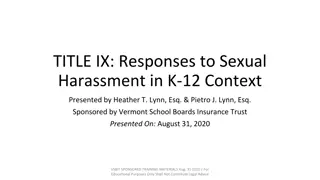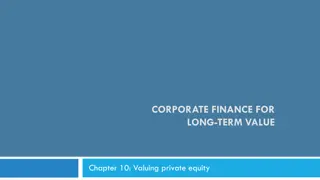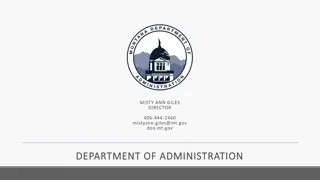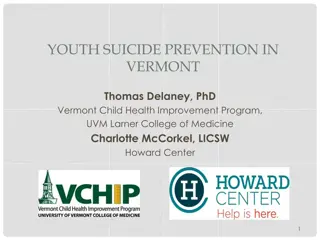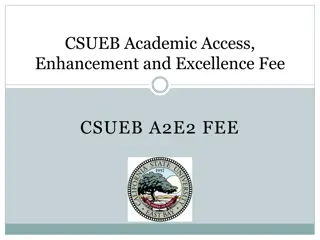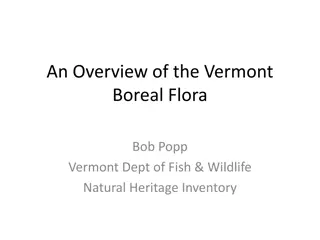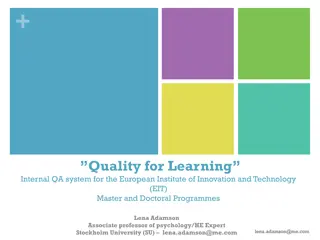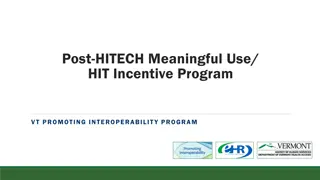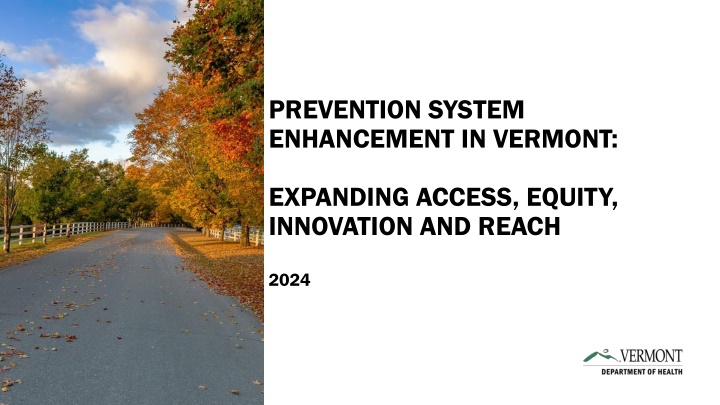
Enhancing Prevention Systems in Vermont for Access, Equity, and Innovation
"Discover how Vermont is enhancing its prevention system to expand access, equity, and innovation in dealing with substance use issues. Learn about the strategies, funding structures, and innovative approaches implemented for a more effective prevention framework."
Download Presentation

Please find below an Image/Link to download the presentation.
The content on the website is provided AS IS for your information and personal use only. It may not be sold, licensed, or shared on other websites without obtaining consent from the author. If you encounter any issues during the download, it is possible that the publisher has removed the file from their server.
You are allowed to download the files provided on this website for personal or commercial use, subject to the condition that they are used lawfully. All files are the property of their respective owners.
The content on the website is provided AS IS for your information and personal use only. It may not be sold, licensed, or shared on other websites without obtaining consent from the author.
E N D
Presentation Transcript
PREVENTION SYSTEM ENHANCEMENT IN VERMONT: EXPANDING ACCESS, EQUITY, INNOVATION AND REACH 2024
PRESENTOR: Traci Sawyers Director of Prevention Services Division of Substance Use Programs (DSU) Vermont Department of Health Vermont Department of Health 2
Prevention Enhancement in Vermont Focus of Presentation Background on substance use in Vermont Vermont s process for receiving flexible state funding and how those dollars align and are used with federal funding it receives The planning process for prevention system enhancement to implement a new funding structure and broader approach How the SPF is embedded in this model to determine regional priorities and guide regional funding allocations How innovative approaches, non-traditional partners, and secondary prevention are included in this work Vermont Department of Health 3
Substance Use in Vermont A Alcohol use lcohol use Vermont Department of Health 4
Substance Use in Vermont Cannabis use Cannabis use Legalized for those 21 and older in 2018 Regulated retail cannabis market opened in 2022 Vermont Department of Health 5
Substance Use in Vermont Opioid Use Opioid Use Vermont Department of Health 6
Substance Use in Vermont Low perception of harm Low perception of harm Middle School Middle School Vermont Department of Health 7
Background on Prevention in Vermont The Prevention Unit sits in the Division of Substance Use Programs within the Vermont Department of Health (VDH) Vermont Department of Health 8
Background on Prevention in Vermont Director of Prevention Services In the Prevention Unit, there are five administrative positions and 11 Prevention Consultants (PCs) who are based in the VDH Health District offices. The PCs form a Vermont Prevention Consultant Network that provides training, technical assistance and more. Assistant Director of Prevention Services Prevention Services Manager Prevention Services Manager Substance Abuse Program Manager St. Johnsbury PC Morrisville PC St. Albans PC Barre PC Substance Abuse Program Manager Bennington PC Burlington PC Springfield PC Newport PC Middlebury PC Rutland PC Brattleboro PC Vermont Department of Health 9
Background on Prevention in Vermont, contiued Prevention (VDH/DSU) funds: Coalitions School-based services Prevention Consultant Network Legislatively mandated Drug Disposal program College coalition Statewide organization that supports healthy coalitions Media messaging Vermont Prevention Lead Organizations Vermont Department of Health 10
Background on Prevention in Vermont, continued Before this state funding: Only receiving SUPTRS Block Grant and Partnerships for Success (PFS) funding Focus on primary prevention and youth and young adults. DSU funded individual coalitions, schools and health districts via PFS/Regional Prevention Partnership (focus on menu of evidence-based strategies). Lost $1.4 M a year of PFS funding from the 2015-2020 grant to Vermont s 2020- 2025 grant (went from 12 to 5 health districts) caused significant gaps and disparities when funding went away. Tobacco Control program in different VDH division CDC vs SAMHSA funded. Vermont Department of Health 11
Process for Receiving Cannabis Excise Tax Funding January 2018 - Vermont became the first state to legalize adult use marijuana through legislation and established the retail market the next year. Vermont imposes a fourteen percent (14%) excise tax on the retail sale of cannabis and cannabis products. Includes food or beverages that contain any cannabis or cannabis product. Sales and use tax are also collected (6%). The legislation states that 30% of Cannabis Excise Tax dollars will go to substance misuse prevention (not to exceed to $10 million). The Cannabis Control Board prioritized over the 30% for prevention in the first three years of the market (sunsets in FY25) language put in FY23 budget bill. In FY2023, $3 million was appropriated in the Governor s Budget starting with general fund dollars with the intent of yearly funding and replacement with excise tax as available. This is our 3rd year of receiving $3 million but not without political scrutiny also 30% would have been $5 million this year. Vermont Department of Health 12
Key activities Upon receipt of $3 million in state funds (FY23) Completed 11-month prevention systems enhancement planning process with state prevention partners and the Public Consulting Group. Provided interim bridge funding to coalitions and other partners to ensure established prevention work continued during this time. With input, decision made by DSU to implement a regional funding structure to keep funding closer to the communities and regional needs, data, and priorities. Four regional Vermont Prevention Lead Organizations (VPLOs) established July 2023 covering the state and leading prevention efforts and allocating prevention funding within their region. VPLOs conducted regional assessment (data analysis and capacity) which identified regional priorities and guided funding decisions in Fall of 2023. Subgrants to prevention partners began January 1, 2024 54 total over the four regions. Vermont Department of Health 13
Structural Changes Previous Structure Federal funding only and DSU subgranting to individual coalitions or in specific VDH health districts (through PFS/RPP) New Structure VPLOs subgrant within a broader region (cover 2 to 4 VDH health districts) Key elements of the VPLO structure includes regional assessments/strategic planning and fiscal management/subgranting. Seventy percent of the VPLO award is required to be subgranted in the region. Each VPLO must establish a Regional Advisory Board to make recommendations on subgranting There must be at least two advisory board members from each health district covered by the VPLO An overarching goal of this funding is to sustain existing substance misuse prevention coalitions, build additional prevention capacity, and reach gap areas to ensure statewide prevention coverage of all 12 health districts. Vermont Department of Health 14
Benefits of Regional Approach Provides a guiding vision and strategy, supports aligned activities, establishes shared measurement systems, builds public will, and leverages additional funding to support prevention. Is guided by the Collective Impact approach and the concept of a backbone organization that coordinates, mobilizes and facilitates prevention in a region. Funds are close to communities which allows for local decision making at the community-level. Optimizes regional assets and variability. Allows more flexibility to fund prevention activities according to need and impact and to consider and fund a variety of approaches. Allows for smaller grants. Vermont Department of Health 15
Foundational Components of Regional Structure Employs an upstream public health approach. Embeds and integrates prevention in communities, community services, health care and more. Allows prevention practices to expand and evolve based on current conditions and needs. Weaves prevention across the continuum, from prevention through recovery and harm reduction. Ties funding allocation to an authentic SPF process from the very beginning. Leverages additional funding in the prevention system. Defines and ensures baseline prevention in Vermont. Creates/establishes actionable regional health disparity impact statements. Is continually evolving - this new enhanced system will take years to build and refine Vermont Department of Health 16
System Enhancement Vision DSU envisions a substance misuse prevention system in Vermont that is sustainable, scalable, and equitable sustainable, scalable, and equitable. Includes all age groups Addresses disparities Follows the Vermont Prevention Model Focuses on all substances Built upon the Strategic Prevention Framework and other research-based prevention principles while allowing for flexibility and innovation Supports and sustains substance misuse prevention coalitions Is embedded in other organizations and systems such as schools, third spaces, higher education Engages untapped groups and partners Is coordinated and cost effective Includes and values primary, secondary, and tertiary prevention Is continually evolving A system that uses evidence based/informed/best practice based/informed/best practice programs, policies and innovative programs, policies and innovative approaches approaches to prevent the onset of substance misuse disorder, delay initiation of use, promote healthy lifestyles and optimize well-being among individuals, families, and among individuals, families, and communities across the lifespan communities across the lifespan. evidence- - Vermont Department of Health 17
What success looks like Relevant and effective substance misuse prevention efforts statewide. Collaborative efforts driven by reliable and timely data that address contributing factors that lead to use and includes participation from priority populations. An increase in substance misuse coalitions that are sustained and thriving. Inclusion of innovation and untapped prevention partners in this work. An expanded and supported prevention workforce. An understanding by communities and stakeholders about what substance misuse prevention is and its impact. Vermont Department of Health 18
Innovation in the Model Inclusion of full spectrum of prevention (primary, secondary, tertiary), all ages and substances, boarder definition and expansion of prevention. Implements evidence-based, evidence informed, promising practice and community-driven strategies and approaches. Capacity-building, project-based and other activities beyond only strategy implementation. Meets organizations and people where they are ( nothing about us without us ). Develops new approaches and tools related to both programming and evaluation. Addresses upstream and environmental factors that contribute to community health (social determinates of health). Flexibility for both VPLOs and grantees while holding them to a set of regional goals that they determine based on data this has led to an increased and diverse number of activities happening related to prevention across the state. Engagement of non-traditional partners across sectors to embed prevention in their work. Vermont Department of Health 19
Health Equity in the Model According to Healthy People 2030, health equity is defined as "the attainment of the highest level of health for all people. Achieving health equity requires valuing everyone equally with focused and ongoing societal efforts to address avoidable inequalities, historical and contemporary injustices, and the elimination of health and health care disparities." Health Equity in the VPLO model (to date) focuses on: Health Equity in the VPLO model (to date) focuses on: Using data to identify and address health disparities (each develops a health disparities impact statement for the region*). Creating a more strategic focus on priority populations based on assessment data that is tied to funding decisions. New partners diversify the prevention workforce. * Example: Prevention is an ongoing project in a continually changing environment. Historically, subject to federal and other funding sources, services have been sporadic. Not every community in VT has equal access to prevention services. One of PL4 s key missions is to identify and decrease geographic, demographic, and other gaps in services based on population needs. Vermont Department of Health 20
Key Pillars of Enhanced Prevention System The following were identified in the planning process as needed to support the prevention systems enhancement we are undertaking: Equity & Cultural Inclusion Evaluation Sustainability Workforce Development In Year 2 and beyond, we will be building resources and capacity externally and internally to ensure these components guide and ground prevention in Vermont Vermont Department of Health 21
Other Core Components Under Development Healthy Coalitions Convener of coalitions for networking and workforce development. Dedicated to increasing effectiveness and promoting evidence-based prevention. Prevention Science Holds expertise in current advancements in prevention science. Supports the review and approval of evidence-based programs and interventions. Supports review of innovative projects. Priority Populations Provides training and technical assistance to engage identified priority populations in prevention. Mobilizes community organizations and supports fostering non-traditional partnerships across health districts and provides insights for health disparity plans and adaptations for interventions. School-Based Supports school-based prevention grantees. Supports higher education initiatives. Develops tools and resources for engaging schools in community-based substance use prevention. Vermont Department of Health 22
Work to Date VPLOs have: Established regional advisory and coordination structures. Conducted assessment to identify strengths and gaps in each health district and region, determined regional priorities that serve as the basis for funding allocation. o SPF process - use rates/trend assessment and capacity assessment Established regional priorities based on assessment. Released RFPs in October; funding began January 1, 2024. Began tracking and expanding baseline prevention in gap areas media messaging, community education, drug disposal promotion, trainings, and events. Developed a Health Disparities Impact statement (a compilation of data sources that outlines trends for different populations in the region). Vermont Department of Health 23
Process To Apply for Funding from VPLOs Each subgrantee applying to a VPLO needed to identify a risk and/or protective factor and complete a basic logic model. Training was provided on the SPF and Prevention 101(including logic models) as well as Grant Writing, Results Based Accountability, Collective Impact. RFP focused regional funding priorities based on assessment. Regional funding criteria based on priorities. Regional Advisory Board made funding recommendations to VPLO. Vermont Department of Health 24
DSU Work to Support Prevention Leads/Regional Structure Provided guidance (definitions, answering questions, helped to problem-solve, created resources and reference documents, etc.) Offered maximum flexibility given regional variability and structure. Each month meet individually with each VPLO and have an All-VPLO meeting. Prevention Consultant s support VPLOs in teams: serving on regional coordination teams, assisting with assessment, providing training and technical assistance to advisory boards, subgrantees and communities. Communicating and messaging around new structure. Reporting, metrics, and evaluation. Beginning to work on foundational pillars and other key components to support the system. Vermont Department of Health 25
Partners Funded in Year 1 Substance Misuse Coalitions Parent Child Centers Domestic and Sexual Violence Organizations Recovery Centers Health care providers/FQHCs Court Diversion/Community Justice Centers Refugee Associations Recreation Departments LGBTQ+ Organizations Community Arts Centers Third Spaces Older Adult Service Providers Regional Planning Commissions Schools Untied Ways Hospitals Vermont Department of Health 26
Projects Funded in Year 1 Vermont coalitions implementing evidence-based programs A parent child center offering prevention trainings for early childhood educators and other partners serving families with young children. Services for justice involved youth with substance misuse challenges Embedding Peer Support Recovery Coaches in schools A student Leadership for Social Justice Conference Expansion of existing youth asset building and health equity programming Trainings and support services for BIPOC and LGBTQ+ Youth Substance use prevention case management in primary care settings Afterschool/third space programming Building a coordinated Community Response Model for those experiencing domestic violence and have a history of substance misuse A clinic that provides free healthcare to uninsured people in central VT Education and programing for older Vermonters via Area Agencies on Aging Vermont Department of Health 27
Q1 and Q2 Metrics Start-Up What priorities were identified and how they were identified. Capacity within the region to do prevention work and how that capacity was determined. What structures were established for new and continuing prevention work to be done. How both community partners are DSU staff are included in work. How health equity fits into the work and approach to building and broadening prevention work within the region. Approach to building a regional advisory board and does the board have representation from each health district within the region. Successes and challenges. Vermont Department of Health 28
Q3 and Forward Metrics Who the subgrantees are. How subgrantee work fits into regional priorities. Number served and how that number was determined. Demographics of those served. Baseline prevention coverage. Capturing work across Vermont Prevention Model. Primary and secondary prevention activities. Vermont Department of Health 29
Successes to Date 54 subgrantees. Both operating and strategy support for 20 existing substance misuse prevention coalitions. Subgrantee activities were differentiated while still coordinated through a mutually reinforcing plan of action. Led change management and messaging to bring regions together. Development of a Substance Misuse Employer Toolkit. SPF/RBI/Collective impact embedded. Provided funding and a process for similar coalitions in a region for strategic planning to increase collaboration and efficiencies. Created regional data dashboards to collect data and measure results consistently. Vermont Department of Health 30
Success to Date, continued Led transition planning when a coalition no longer became viable. Leveraged additional funding streams for evaluation related activities and more. Provided consistent and open communication in the region to build trust, identify mutual objectives, leveraged common motivation and share lessons learned. Incorporated AmeriCorps Vistas, public Health Fellows (CDC), Vermont National Guard placements as part of the coordination teams in regions Received funding and support from hospitals or universities for additional special projects specifically focused on priority areas (e.g. UVM Health Network Project focused on medical students working with older adults around substance use prevention) Funded data driven, comprehensive, evidence-based planning based on the Vermont Prevention Model and the Strategic Prevention Framework vs. one project/strategy. Engaged broader partners in the field of prevention. Vermont Department of Health 31
Challenges to Date Lots of work to build the foundation for the work to be done, be sustainable, and be buildable Specific vision needed Limited and vulnerable vendors and partners Workforce challenges Political challenges Change Vermont Department of Health 32
Lessons Learned/Year 1 Reflections This is the biggest and most radical prevention initiative that we have implemented in Vermont and it will continue to take time to fine-tune the model, structure and more. Regional funding committees engaged in deep conversation that challenged their previous thinking together they were able to push, explore and expand how they thought of prevention in a way that couldn t have come via the state. State money is political. Prevention is not well understood we need to define and show outcomes. Partners may not be at a point to be thinking as innovatively and upstream as we are change takes time. Having essentially a backbone organization in a region is critical to sustainability and building capacity far beyond strategies alone or what the state can do. Established with a focus on substance misuse coalitions but this work is about so much more projects, strategies, capacity, sustainability and true systems enhancement. Vermont Department of Health 33
Future Vision Started with $3 million general fund/Cannabis Excise Tax, now 30% of Cannabis Excise Tax not to exceed $10 million as in Vermont statute. Five-year VPLO grant cycles to build on work and foundation. Braided Funding (VPLOs coordinate funding from individual sources, with each individual funding source keeping its specific identity): PFS School funding via SUPTRS Block Grant Tobacco Funds All funding flows through the regional structure to align with needs and priorities of that region based on assessment. Vermont Department of Health 34
Questions? Thank you! Traci Sawyers Director of Prevention Services Vermont Department of Health, Division of Substance Use Programs traci.sawyers@vermont.gov Vermont Department of Health 35

